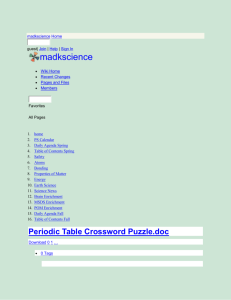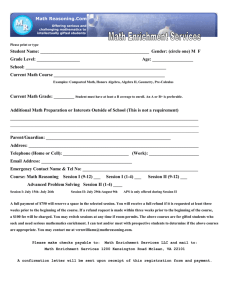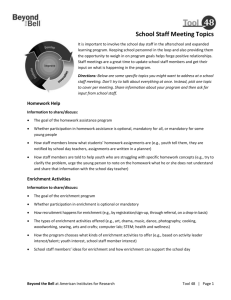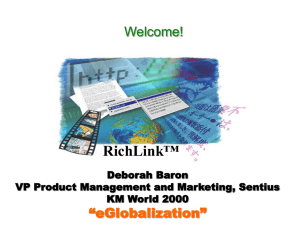A successful job enrichment program should address the important
advertisement
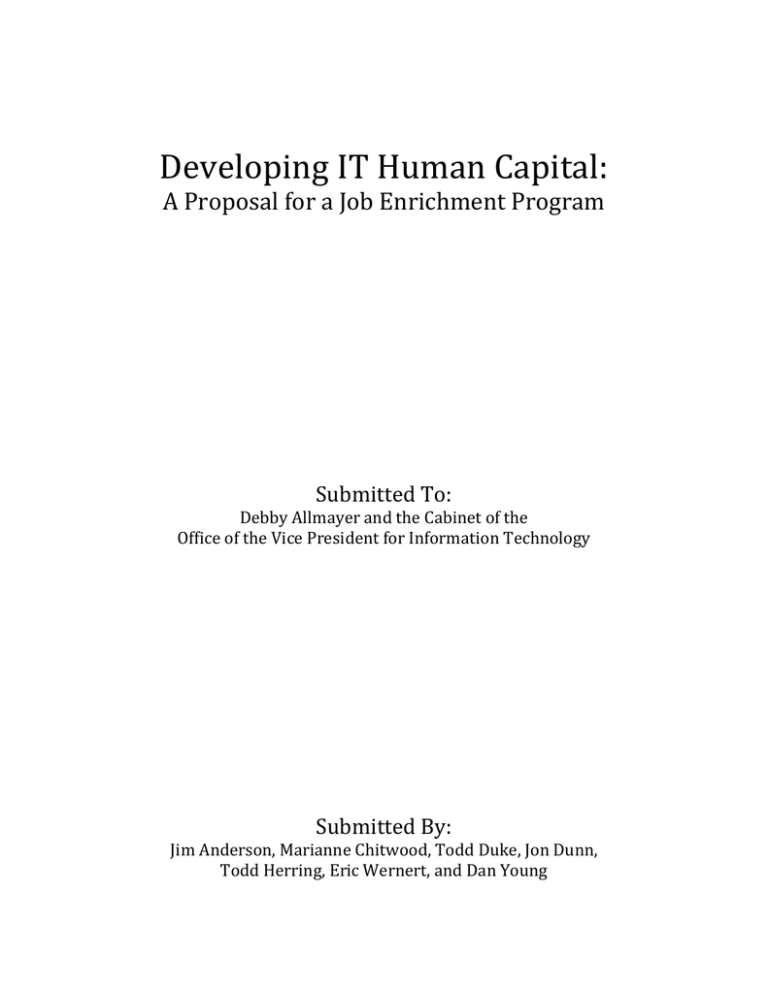
Developing IT Human Capital: A Proposal for a Job Enrichment Program Submitted To: Debby Allmayer and the Cabinet of the Office of the Vice President for Information Technology Submitted By: Jim Anderson, Marianne Chitwood, Todd Duke, Jon Dunn, Todd Herring, Eric Wernert, and Dan Young Table of Contents Executive Summary................................................................................................................................ 4 Background ............................................................................................................................................... 5 Purpose and Objectives ........................................................................................................................ 5 Benefits ....................................................................................................................................................... 5 To Staff: .................................................................................................................................................. 5 To Managers/Departments: ........................................................................................................... 5 Research and Data Collection ............................................................................................................. 6 Feasibility ................................................................................................................................................... 7 Best Opportunities for Job Rotation/Enrichment ...................................................................... 7 Recommendations .................................................................................................................................. 7 Pilot Program ....................................................................................................................................... 7 Evaluation ............................................................................................................................................. 8 Program Name .................................................................................................................................... 8 Stewardship and Flexibility............................................................................................................ 8 Executive Summary In order for IU’s world-class IT staff to work effectively across units and campuses, we need to create opportunities for skills development and collaboration, especially in areas that support Empowering People. We are proposing a job enrichment program, to benefit staff, management, and the university. The term “program” is used loosely in this context; the job enrichment experiences would vary in scope, length of time, complexity, and purpose, as negotiated by participating parties. A successful job enrichment program should address the important human resources considerations of staff retention and succession planning. The career opportunities and new challenges available to staff through job enrichment are likely to help with staff retention. Furthermore, the inter-departmental nature of the proposed job enrichment program will help staff extend their professional network and expose them to the business concerns of other parts of the university. Satisfied and well-rounded staff will stay at IU longer and be better prepared for leadership positions later in their careers. After the project team researched the subject and determined the feasibility of a program at IU, consideration was given to which areas of IT are best suited for job enrichment. In the end, the project team reasoned that the whole spectrum of IT jobs has potential for job enrichment, from part-time help desk technicians to programmers to managers. Success depends on how well participating staff and managers define the scope and expectations of their relationship. A pilot program is highly recommended. The pilot would serve several purposes. It would help to fully assess the feasibility of a broader program, and participants in the pilot could help create templates and assessment tools. Choosing the most suitable, and most willing, participants in the pilot is crucial, as their feedback and help in formalizing the program is necessary to move the program forward. Background Better leverage of resources is front and center in the IU IT Strategic Plan Empowering People (EP) and the IU IT Leadership Program. In order to have IU’s world-class IT staff working together effectively across units and campuses, we need to create and foster opportunities for skills development, projects outside defined job responsibilities, and experiences that cultivate a wider variety of skills as well as enhance job satisfaction and ensure necessary redundancy. A project team from IU’s IT Leadership Program was charged to design a program that develops IT human capital for the extended IT community. Requested deliverables included developing objectives for a successful job rotation program, identifying projects related to EP action items, determining challenges and solutions for moving IT staff into EP assignments, proposing incentives for taking new responsibilities and acquiring new skills, and establishing standards for measuring program outcomes. Purpose and Objectives The purpose of this document is to describe what we are now calling a job enrichment program for IT professionals and technicians at Indiana University, inclusive of all campuses, schools and departments. The program is intended to consider stakeholder needs and address critical IT service demands. Program goals include creating a more flexible work force, building professional development opportunities for staff to improve their skills and enhancing IT relationships between sponsoring departments, particularly where services touch, job functions overlap, or common needs exist. This program is in support of Recommendation 7 of IU’s IT Strategic Plan, Empowering People. Benefits In order for the program to launch, clear benefits to staff, supervisors, and sponsoring departments must be demonstrated. To Staff: Participating staff members can demonstrate to their supervisors and peers not only great initiative, but also a willingness and ability to learn new skills. The program would also offer staff an opportunity to gain on-the-job experience in a new area of expertise or to deepen their understanding of an already familiar subject area. Skill diversity may help participants to meet the minimum qualifications of jobs for future career advancement, and the experience may open doors of opportunity. To Managers/Departments: There are a number of opportunities for sponsoring managers and departments to benefit from participation in a job enrichment program. For example, two or more sponsoring departments could help each other temporarily increase staff levels during peak times, such as rolling out life-cycle workstation replacements during the summer months. Foresighted managers can use the program to develop current staff so that they are capable of meeting future department goals. For example, a manager could send a .Net programmer to learn Cold Fusion, knowing the Cold Fusion skills will be more valuable strategically over the coming years. While some managers may fear losing staff to another department, the fact remains that no manager can (or should) stop someone from leaving their job to pursue other career opportunities. The university as a whole benefits from a modest level of “job hopping”. In most cases, a job enrichment program will not give participants a reason, or necessarily even an opportunity, to leave their original position. Overall, managers gain flexibility in staffing because staff members will return possessing more skills. In addition, by trusting staff to participate in the program, managers are actually providing the kinds of job variety that high performers need to remain committed to their jobs. Ultimately, Indiana University retains its most talented staff. Participation in the program can also build bridges to other departments in order to create and reinforce interdepartmental cooperation. This possibility addresses an important aspect of succession planning, namely, that the next generation of IT leaders need to be well-connected within the university and should understand the business of a variety of schools and departments. Research and Data Collection A literature review and web search were conducted in an attempt to discover whether any successful job rotation or enrichment programs for IT staff had been implemented at other colleges and universities or in the corporate sector. Much literature was found on job rotation for manufacturing and executive positions but minimal case studies and guidance for application of these approaches with IT workers. The literature that was found illustrated a variety of potential benefits of job enrichment opportunities for IT workers, including improved recruiting, increased retention, decrease in incidents of “burn-out,” increased productivity, better awareness of the context of one’s primary job function within the organization, and increased cooperation across units. However, several articles also showed that buy-in at all levels within the organization is essential, as is a clear structure for management of the program.12 Several dozen managers and staff, inside and out of UITS, were surveyed in order to discover attitudes, challenges, and suggestions for a job enrichment program. In all, twenty-two people responded to the survey, which appears at the end of this document. The survey responses were critical in evaluating the feasibility of such a program. Hamilton, Mark and Harris Kern. “Retaining the Best Talent for Software Development.” InformIT, 2001. http://www.informit.com/articles/article.aspx?p=23769 1 McGillicuddy, Shamus. “IT Job Rotation Rare, but Critical for Business Alignment.” Midmarket CIO News, 2007. http://searchcio-midmarket.techtarget.com/news/article/0,289142,sid183_gci1244573,00.html 2 Feasibility Given that this proposal does not call for monetary appropriations, the most common measure for feasibility does not apply. Instead, the feasibility of a job enrichment program at IU depends entirely on the identification of suitable opportunities for job enrichment, participation by employees and managers, and buy-in by department heads. While there are certainly organizational and bureaucratic hurdles to overcome, most respondents to the survey (12 of 22) believed that a job enrichment program is worth the effort to participate in or even help pilot. One of the most daunting bureaucratic challenges involves the inequity a participant in the program may suffer if he or she performs the duties of someone in a higher pay grade. Certainly, in some instances, special arrangements or pay increases may need to be made. However, this proposal does not seek to address how those situations should be handled. In fact, doing so would seriously jeopardize the feasibility of getting a program off the ground. Best Opportunities for Job Rotation/Enrichment Positions that have been identified as potentially good candidates for such a program include web developers, programmers, network engineers, general support technicians, and wire and cable support. Perhaps all IT-related jobs are potential candidates, depending on the nature and scope of the project. A well-defined project is perhaps the most important factor that will determine the best opportunities for job enrichment. For example, imagine a formal program of interested technicians and willing managers to help each other out in predictable and similar times of need -- Life Cycle Funding upgrades. Each year, generally during the summer, many departments across IU procure large numbers of computers to replace outdated staff and faculty computers, and in some cases student lab computers. Rather than staffing all year for their one month of “crunch time”, departments can staff for normal levels and, in essence, “share staff” for this level of highest need. One can also imagine a true job rotation program centered on support services. A new technician hired into a school or department could spend a couple of weeks at the UITS Support Center, a week or two within LSP Services, and perhaps a week or two as a Technology Center Consultant or a consultant at a Center for Teaching and Learning. As in the case above, this sort of job rotation could be well-defined, formalized, and structured in a way that ensures success and longevity. Recommendations Pilot Program In order to be able to fully assess the feasibility of a job enrichment program and define the program’s parameters, a proof of concept is needed. A pilot program of one or more job rotations would serve not only as a model for others, but, if closely overseen, would also provide the necessary information to thoughtfully formalize processes, forms, and policies. Even so, a few things are understood. For example, after a staff member has chosen a job enrichment goal, his or her supervisor can work with the UITS Human Resources department to identify appropriate opportunities. Staff would need to work with both their current supervisor and “adopted” supervisor to coordinate the assignment, identify goals, and agree on timelines, performance expectations, and other issues. Jim Anderson has graciously offered to pilot a program involving his helpdesk staff. Several other colleagues in the 2009 ITLP cohort have also offered to pilot a program, so it would seem that getting participation is easily accomplished. However, motivating the participants to contribute time and energy to help build and formalize the process will be a key challenge. Evaluation Evaluating the program’s effectiveness should be done through a process that documents the end results of the enrichment program. The evaluation should compare the participants’ job satisfaction before and after participating and determine whether or not the program has fulfilled its objectives and to what extent. This might be something that could be incorporated into the performance review process between a staff member and their supervisor. The job enrichment program needs to strike a balance between operational need and job satisfaction. If after the trial it is determined that significant changes are needed, it might be useful to establish a “job enrichment task force” which could be comprised of a cross-section of employees, and give them responsibility for deciding which enrichment options make the most sense. If the pilot is determined to be a success and a broader rollout is desired, it will be important to communicate the program to managers and directors, letting people know about the program and why it is valuable. Monitoring efforts and regularly evaluating the effectiveness of what the program is providing will help to further refine and develop its effectiveness. Program Name The name of the program should be self-descriptive enough that when discussing the idea, time isn’t lost explaining terminology. The term “job rotation” has sometimes been used to describe the proposed program, but this term is often used to describe a formal program in which an employee works a fixed period of time at several different jobs in order to gain perspective of the entire business process. This is most common in manufacturing, but also occurs at managerial levels. We seem to be talking about something more than this form of job rotation. One term that aptly describes this program may be “job enrichment”. However, even that term requires explanation. The importance of this aspect of the program should not be underestimated, and the issue should remain open until a satisfactory name is found. Stewardship and Flexibility The term “program” implies something that people will participate in more than once, something that lasts over a long period of time, and something that is formalized. It implies a steward of the program to shepherd people through the process. As part of the feasibility assessment, thought must be given to the questions of who “owns” it, and how it operates. Presumably someone in UITS/OVPIT Human Resources or even University Human Resource Services will need to own and operate the program. Since one size will not fit all, a certain degree of flexibility is required. Interested parties would need to come to some understanding about the length and depth of participation. The program would need to accommodate parties interested in participation lasting from two weeks to one year or longer. All such agreements will require a memorandum of understanding that all parties should sign, including affected employees and department heads. After the pilot program concludes, careful consideration must be taken to debrief participants and evaluate the results, with the goal of creating the documentation necessary to formalize a program. One aspect of formalizing a program would be to create some sort of “clearinghouse” where interested parties can make their wishes and requirements known. This could be manually handled through UITS Human Resources, or a tool such as a Wiki or social networking tool could be used to communicate information about opportunities and interested staff.
